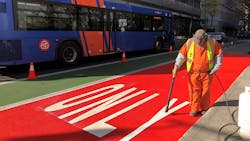Bus lanes speed up trips on 10 TriMet lines
TriMet has announced the bus-only and bus-priority lanes the Portland Bureau of Transportation (PBOT) installed earlier this year have sped up trips for thousands of TriMet bus riders.
The lanes were installed on SW Madison between 1st and 4th Avenues and on NW Everett between NW Broadway and the Steel Bridge. In the months since, delays have decreased on all the bus lines that use the lanes. As a result, riders keep moving, spending less time in traffic and getting where they need to go faster.
SW Madison bus and bike-only lane
PBOT created the new lanes as part of the Central City in Motion project. The program makes improvements that not only speed up buses but also make the streets safer and help keep everyone moving. The first project, completed in May on SW Madison Street, created a bus and bike-only lane that reduced delays on Line 2-Division, Line 6-Martin Luther King Jr Blvd, Line 10-Harold St and Line 14-Hawthorne. During the evening commute, when buses travel eastbound toward the Hawthorne Bridge, the four-block improvement moves bus commuters up to 76 percent faster between downtown Portland and the Hawthorne Bridge.
Delay decreases during the evening rush include:
- Line 2-Division: 68 percent
- Line 6-Martin Luther King Jr Blvd: 26 percent
- Line 10-Harold St: 60 percent
- Line 14-Hawthrone: 76 percent
NW Everett bus priority lane
PBOT re-striped lanes on NW Everett Street in August, creating a Business Access and Transit (BAT) lane approaching the Steel Bridge. Six bus lines use the bridge to cross the Willamette River – Line 4-Fessenden, Line 8-Jackson Park/NE 15th, Line 16-Front Ave/St Helens Rd, Line 35-Macadam/Greeley, Line 44-Capitol Hwy/Mocks Crest and Line 77-Broadway/Halsey. In the seven-block stretch between NW Broadway and the bridge, five of the lines saw delays decrease by 25 percent or more. Trips on Line 8 showed the greatest improvement; the new lane cut travel time during the evening commute by nearly 35 percent or more than a minute and a half.
Delay decreases during the evening rush include:
- Line 4-Fessenden: 26 percent
- Line 8-Jackson Park/NE 15th: 34 percent
- Line 16-Front Ave/St. Helens Rd: 14 percent
- Line 35-Macadam/Greeley: 29 percent
- Line 44-Capitol Hwy/Mocks Crest: 27 percent
- Line 77-Broadway/Halsey: 25 percent
Combined, the 10 lines that use the bus-priority lanes provide about 50,000 trips a day. While they all serve riders traveling out of downtown Portland, the benefits extend to neighborhoods in North, Northeast and Southeast Portland, Gresham and Troutdale.
The new lanes are among several regional initiatives to speed up transit and make it a more attractive option than driving alone. Earlier this month, Multnomah County created a bus-only lane on the Burnside Bridge that improved eastbound trips on bus lines 12, 19 and 20. In October, PBOT began a test of painting transit-priority lanes red. The red paint, on SW Main Street, NE Grand Avenue and NE MLK Boulevard, is designed to make transit-priority lanes more visible and to help reduce misuse. PBOT will host open houses on its “Rose Lane Project” in December to share information and hear feedback about the red paint and other improvements.
Making transit better
TriMet thanks PBOT and other local, regional and state partners for helping make transit better. When trips on buses and trains are safe, fast and reliable, transit becomes a more viable option for getting to work, school, appointments and events. As transit use increases, congestion and air pollution decrease.
